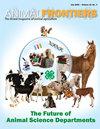Implementation of genomic selection in the poultry industry
IF 4.2
2区 农林科学
Q1 AGRICULTURE, DAIRY & ANIMAL SCIENCE
引用次数: 72
Abstract
Genomic selection using high-density SNP panels was first implemented in dairy cattle breeding programs. It provided benefits in terms of reduced generation intervals, improved accuracies of selecting young animals, and reductions in costs associated with the requirement of progeny testing bulls in traditional breeding programs (Hayes et al., 2009). Several distinct features of the poultry breeding industry differ markedly from dairy cattle breeding and influence the manner in which genomic selection can be used for genetic improvement in poultry breeding: · Traditional genetic improvement programs in poultry already have short generation intervals (multiple overlapping generations per year with selection every 6 wk in broilers, non-overlapping annual generations in layers). There is some scope for shortening the generation interval in layers but not as much as was the case for dairy cattle breeding where bull pathways could be reduced in length from greater than 6 yr to less than 3 yr (Schaeffer, 2006, Schefers and Weigel, 2012).在家禽业实施基因组选择
利用高密度SNP面板的基因组选择首次在奶牛育种计划中实施。它提供了以下方面的好处:缩短了世代间隔,提高了选择幼畜的准确性,并降低了传统育种计划中与后代测试公牛要求相关的成本(Hayes等人,2009)。家禽养殖业与奶牛养殖业有几个明显不同的特点,影响了基因组选择在家禽育种中用于遗传改良的方式:·家禽的传统遗传改良计划已经具有较短的世代间隔(肉鸡每年有多个重叠世代,每6周选择一次,蛋鸡每年无重叠世代)。在产蛋鸡中,缩短产蛋鸡的产蛋期是有一定的余地的,但不如奶牛育种那么大,在奶牛育种中,公牛的繁殖周期可以从6年以上缩短到3年以下(Schaeffer, 2006; Schefers和Weigel, 2012)。
本文章由计算机程序翻译,如有差异,请以英文原文为准。
求助全文
约1分钟内获得全文
求助全文
来源期刊

Animal Frontiers
Veterinary-Food Animals
CiteScore
6.50
自引率
5.60%
发文量
74
期刊介绍:
Animal Frontiers is the official journal of the following globally active professional animal science societies:
ASAS, the American Society of Animal Science
CSAS, the Canadian Society of Animal Science
EAAP, the European Federation of Animal Science
AMSA, the American Meat Science Association
These organizations are dedicated to the advancement and dissemination of science-based knowledge concerning animal agriculture. Animal Frontiers provides a novel forum for innovative and timely perspectives that have relevance to understanding the complex dynamics at work through animal agriculture. Animal Frontiers publishes discussion and position papers that present several international perspectives on the status of high-impact, global issues in animal agriculture. Every issue will explore a theme of broad and current interest within animal science and animal agriculture.
 求助内容:
求助内容: 应助结果提醒方式:
应助结果提醒方式:


